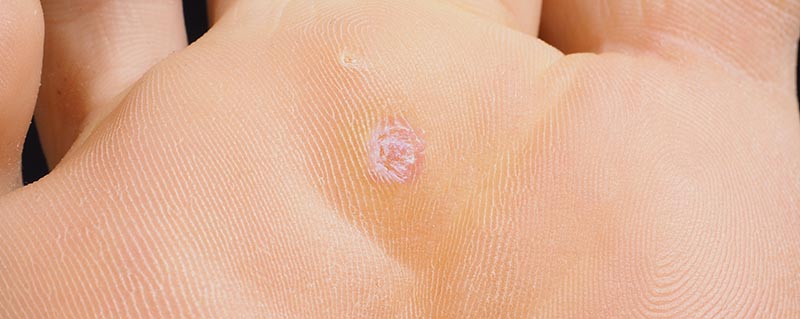Plantar Wart
What are Plantar Warts?
Plantar warts are small growths that develop on skin infected by the Human Papilloma Virus (HPV). These warts can appear anywhere on your foot, but they’re most commonly located on the bottom of your foot.
There are two types of plantar warts:
- A solitary plantar wart is a single wart. It can increase in size and may eventually spawn more warts.
- Mosaic plantar warts are several small warts that grow together in one area.
Who Typically Gets Plantar Warts?
Children, elderly individuals, and adolescents are most likely to get plantar warts.
A weak immune system is one plantar wart cause. Individuals who have a weakened immune system are more susceptible to plantar warts because they can’t fight off the virus that causes the warts.
Going barefoot increases your risk of getting plantar warts, especially when you’re at a locale where HPV is common. HPV prefers moist, warm environments. If you walk barefoot at a locker room or near a swimming pool, you have a higher chance of getting plantar warts.
Plantar Wart Symptoms
The plantar wart appears as a small fleshy growth on the bottom of your foot. Your skin may look tough and as if it’s thickened.
There may be small black pinpoints on the growth. These pinpoints are known as “wart seeds” and are actually tiny, clotted blood vessels.
Some plantar warts cause pain or tenderness when you’re on your feet. Touching or squeezing the wart can also be painful.
Dangers of an Untreated Plantar Wart
If your plantar wart causes pain or discomfort, you may intentionally or unintentionally change how you walk or stand to reduce pressure on the wart. These gait and posture changes can cause joint or muscle discomfort.
An untreated plantar wart can spread, causing you to have more warts.
Treatment Options for Plantar Warts
Some plantar warts go away on their own, without any type of plantar wart treatment. However, many patients prefer faster plantar wart removal options.
Once your doctor has confirmed that you have a plantar wart (through an examination and biopsy), they’ll suggest the best treatments for your needs.
One alternative is a prescription-strength peeling medicine. You apply this to the wart daily to remove a few layers at a time.
Another option is cryotherapy. Cryotherapy is done in-office and consists of freezing the wart off with liquid nitrogen.
Your doctor can also remove your wart with a minor surgical procedure. Laser treatment is another practical solution for removing some plantar warts.
If your immune system is weak, your doctor can prescribe medication to strengthen it so that your body can better fight off HPV.
Contact Our Office
Need to schedule an appointment for your foot wart removal? Contact us online to schedule an appointment or call us at 949-364-9255.
Contact Us
Ladera Ranch
333 Corporate Dr. Ste 230, Ladera Ranch, CA 92694
Tel: (949) 364-9255 (WALK)
Fax: (949) 364-9250
Office Hours:
Monday - Friday: 9am - 5pm
*(Lunch 12 noon - 1pm)
Orange
2617 E Chapman Ave. Ste 303, Orange, CA 92869
Tel: (714) 639-7993
Fax: (714) 639-0729
Office Hours:
Monday - Friday: 9am - 5pm
*(Lunch 12 noon - 1pm)

